List of Authors
>>About this blog
Recent blog post
|
[Dimini ☆ Cricket]
May 28, 2017 16:00
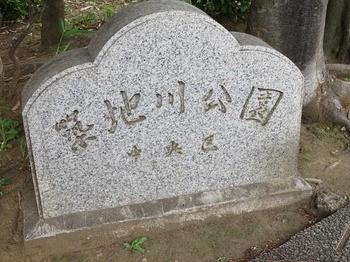
Tsukiji River Park in Akashicho is a park that was originally reclaimed from the Tsukiji River, but roses are blooming in two flower beds around the ruins of the Akatsuki Bridge bridge in it (map below, red)
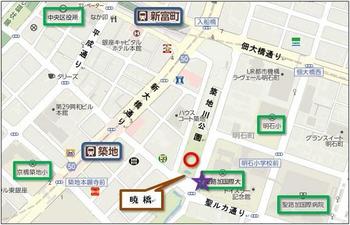
Unfortunately, I don't know the name of the rose, but it's a beautiful single-flowered red rose.
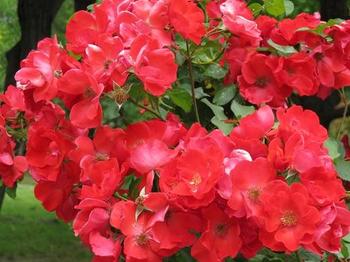
It has a large number of flowers in bloom (spray bloom).
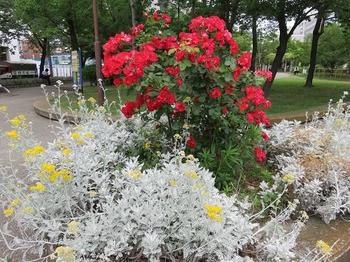
The contrast between the silver leaf of Shirotaegiku, the origin of the plant, and the yellow flower, makes the color of the flower even more prominent. As a companion plant for roses, it was a new discovery that Shirotaegiku fits so well.
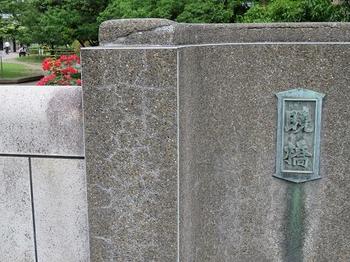
On the sidewalk of St. Luke International Hospital, which separates the road from Tsukiji River Park where these roses are blooming, there are monuments of "Takumi Asanouchi's House Ruins" and "The birthplace of Ryunosuke Akutagawa" (map above, purple ☆)
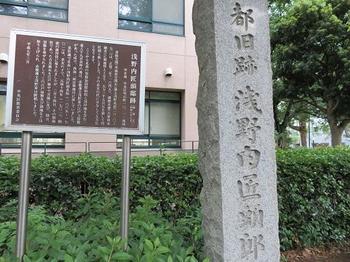
It is said that Uchi Takumito's residence was 9,000 tsubo at the time, but after a famous blade wound incident in Chushingura, he was called to the Shogunate.
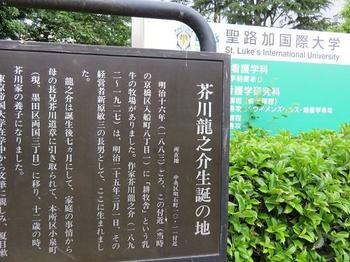
In addition, Ryunosuke Akutagawa was born near here, and his father, Toshizo Niihara,  ran a ranch called Komakisha and manufactured and sold milk and butter to foreign partners. . This neighborhood is a foreign settlement, and Japanese people were not allowed to live, but they were exceptionally allowed because they were engaged in business with foreign partners. ran a ranch called Komakisha and manufactured and sold milk and butter to foreign partners. . This neighborhood is a foreign settlement, and Japanese people were not allowed to live, but they were exceptionally allowed because they were engaged in business with foreign partners.
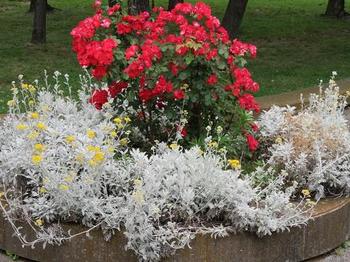
     
[Minori]
May 26, 2017 16:00
Hello, this is Minori . .
I went to St. Luke's International Hospital Toysler Memorial Hall and the ruins of the American Embassy.
It was a nice day.
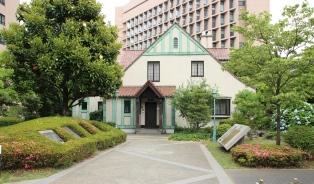
[Toysler Memorial Hall] Resident Tangible Cultural Property (Place: in front of St. Luke's International Hospital)
Founder of St. Luke's R.B. Toysler (1876-1934)
The Toysler Memorial Hall was built in 1933 as a missionary hall at St. Luke's International Hospital. It is a two-story reinforced concrete building, and the exterior shows a Western-style architectural design that expresses the framework of pillars and beams. It was a wonderful house that I would like to live in.
The monument of Toysler has a statue of Toysler.
[A monument to the site of the U.S. Embassy] Kumin Tangible Cultural Property (Place: In front of Toysler Memorial Hall)
I went to the monument after the American Embassy in front of the Toysler Memorial Hall of St. Luke's International Hospital.
The U.S. Embassy was opened in 1875 (1875) and was later in K until 1890 (1890). It is said that the two-story wooden envoy was a Western-style building with cream-colored paint. The exotic city with Western-style architectures and towering church towers was completely lost in the Great Kanto Earthquake.
The monument in front of the Toysler Memorial Hall is made of stone cut off on the coast of Izu Peninsula, a shield-shaped star-shaped flag, an American national bird, a white head eagle (13 stars in the shield-shaped star-shaped flag and 13 stars around the white head eagle represent the 13 states of the United States at the time), and the five tombs.
<Reference>
Supervision of "Chuo-ku Monoshiri Encyclopedia that can be seen on foot" Chuo-ku Tourism Certification Committee
Monument to the Toysler Memorial Hall of St. Luke's International Hospital
A stone monument explaining the monument to the site of the U.S.
[Sam]
May 26, 2017 09:00
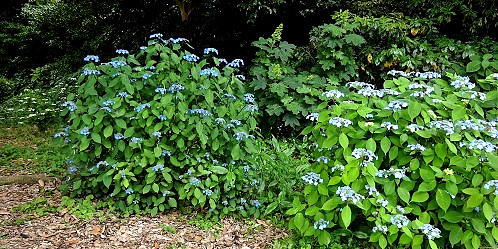
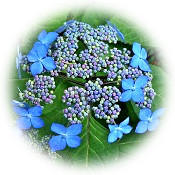 "Yama Hydrangea", which grows near the water bus stop in the Hamarikyu Onshi Garden, is at its best. "Yama Hydrangea", which grows near the water bus stop in the Hamarikyu Onshi Garden, is at its best.
Yama Hydrangea, along with "bigleaf hydrangea" (so-called "hydrangea"), "Western Hydrangea" (Hidlandsia), and "Foreign Hydrangea" (I hear that more classifiers are classified as Hydrangea).
The standard varieties are also called "Kogaku" because they are smaller than bigleaf hydrangea, and "Sawa Hydrangea" because they tend to grow along moist forests and swamps.
In addition to gaku blooming, there is also Temari blooming, and the small elliptical leaves are thin, glossy, thin branches, and delicate.
As a whole, the impression is full of wildness, and the flower color and flower shape are said to have many variations depending on the region.
In cobalt blue, pale blue and pure white, you can enjoy a variety of "ornamental flower" flower colors for each plant.
[Dimini ☆ Cricket]
May 24, 2017 16:00
There is a parking lot  for sightseeing buses at the corner for sightseeing buses at the corner  of the Ichiba Bridge intersection in front of Tsukiji Market, which is full of tourists from Tsukiji Market every day. of the Ichiba Bridge intersection in front of Tsukiji Market, which is full of tourists from Tsukiji Market every day.  
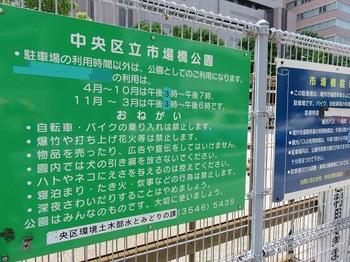
Behind it is a small "Ichiba Bridge Park", and there is a monument in the planting that says "the birthplace of Tokyo blind school, the place where Japanese Braille was established" (map below, red) Place).
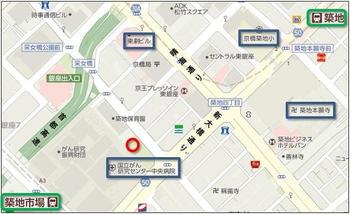
This is to commemorate the opening of the predecessor of the University of Tsukuba Special Needs School for the Visually Impaired (School for the Blind) and the Hearing Special Needs School (School for the Deaf) in 1880 (Meiji 13) as the Rakuzenkai Kuminin School.
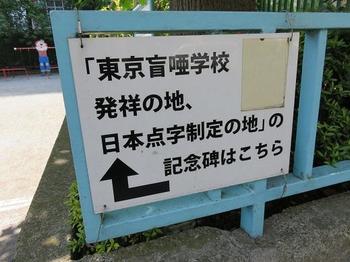
It is said that Kunnuiin soon became Kunnunblind, became a school under the direct control of the Ministry of Education, and was renamed Tokyo School for the Blind in 1887 (Meiji 20).
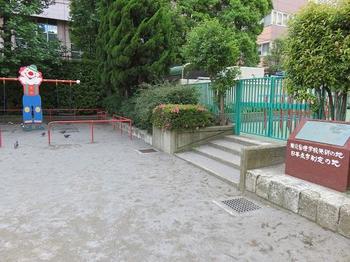
Kuraji Ishikawa of the Tokyo School for the Blind, in 1890 (Meiji 23), invented six-point Braille, which was enacted as "Japanese Braille" and became widely used in Japan.
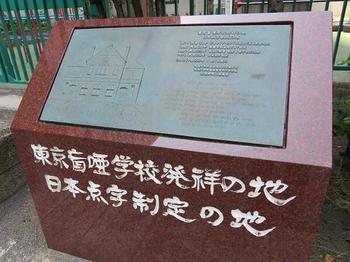
The stone monument is easy to understand for the visually impaired, and it seems that it is created with attention to the size and shape that is comfortable to touch.
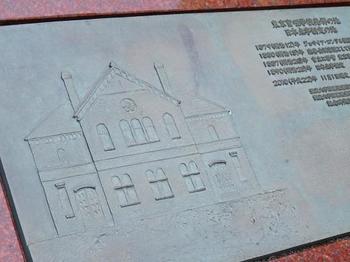
The bronze fitted in the stone monument has relief in the shape of the school and has a chronology of Braille and print. fitted in the stone monument has relief in the shape of the school and has a chronology of Braille and print.
The Tsukiji / Akashicho area is famous as the birthplace of naval-related and mission schools, but I would like you to stop by such a monument.
     
[Dimini ☆ Cricket]
May 19, 2017 14:00
If you walk along a street that you don't usually walk, you will find new discoveries.
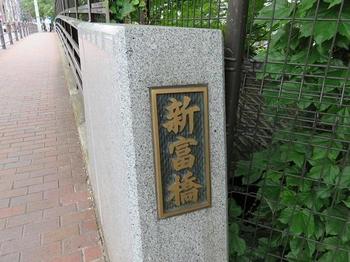
Moreover, this time, the best timing
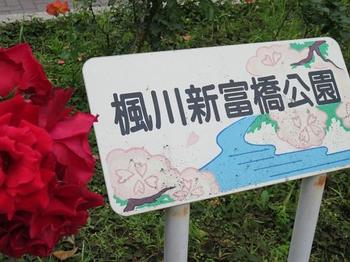
The roses of Momijigawa Shintomi Bridge Park beside Shintomi Bridge, which was built over the Tokyo Metropolitan Expressway, are in full bloom.
It's very close to Kyobashi Plaza. 
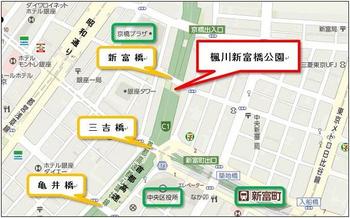
This park is much smaller than the Tsukiji River Shukubashi Park, which I introduced on a blog the other day, and the number of roses is small, but red, pink, yellow and orange roses are in full bloom.
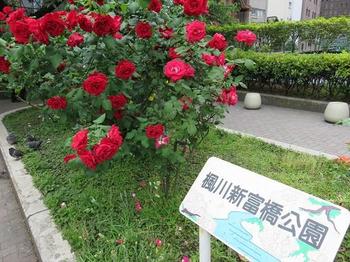
I thought there were more large wheels than Shukubashi Park.
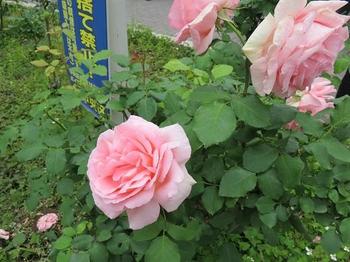
Perhaps because I went  to the lunch break, this park was completely functioning as an adult smoking space rather than for children. to the lunch break, this park was completely functioning as an adult smoking space rather than for children.
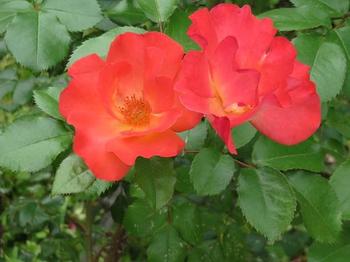
For a blissful time, everyone was smoking under the Fuji shelf in the park
I missed the flowering season of this wisteria.
Pity
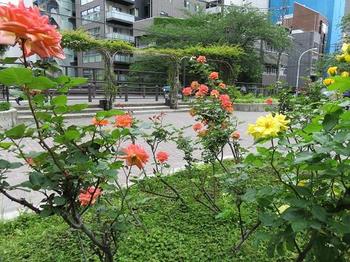
     
[Sam]
May 18, 2017 18:00
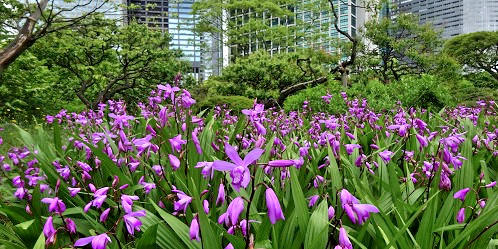
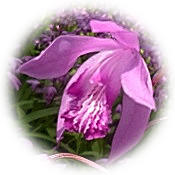 At the Hanaki Garden in the Hamarikyu Garden, silane (Shiran) is at its best. At the Hanaki Garden in the Hamarikyu Garden, silane (Shiran) is at its best.
The clusters create a stunning landscape.
Shiran is perennial plant of the family Orchidaceae.
One of the reasons for the orchid family is strong and easy to grow.
In early spring, leaf stems like sasa are stretched from the fake stalks connected underground, and around May, a splendid red-purple flower at the tip closes downward and blooms in a few flowers.
Because it is easy to increase from seeds, breeders seem to be making new kinds of flowers.
"White flower purple orchids" with white flowers, "lipstick purple orchids" with lipstick applied to the tip of the lips, "Three Butterfly blooming" with petals turned lip petals, and "turning purple orchids" with spots are produced.
The underground part is a crude drug, called "white and root", and is said to have a medicinal effect of hemostasis and inflammation.
|
Links
|
![]()
![]()
![]()
![]()
![]()
![]()
![]() ran a ranch called Komakisha and manufactured and sold milk and butter to foreign partners. . This neighborhood is a foreign settlement, and Japanese people were not allowed to live, but they were exceptionally allowed because they were engaged in business with foreign partners.
ran a ranch called Komakisha and manufactured and sold milk and butter to foreign partners. . This neighborhood is a foreign settlement, and Japanese people were not allowed to live, but they were exceptionally allowed because they were engaged in business with foreign partners.![]()
![]()
![]()
![]()
![]()
![]()
![]()










 "Yama Hydrangea", which grows near the water bus stop in the Hamarikyu Onshi Garden, is at its best.
"Yama Hydrangea", which grows near the water bus stop in the Hamarikyu Onshi Garden, is at its best.













 At the Hanaki Garden in the Hamarikyu Garden, silane (Shiran) is at its best.
At the Hanaki Garden in the Hamarikyu Garden, silane (Shiran) is at its best.
